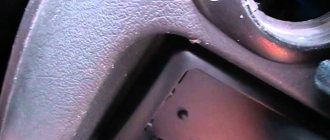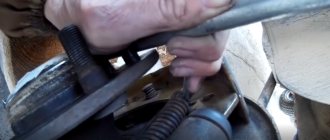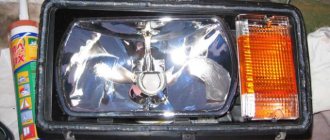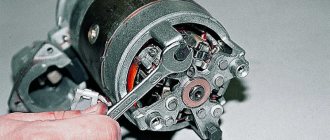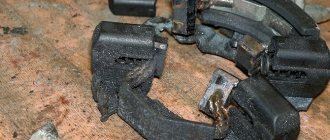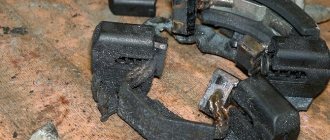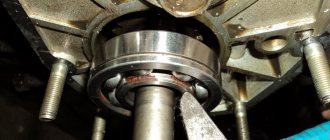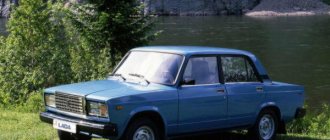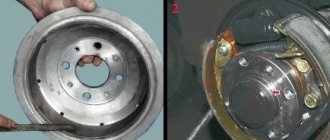Which brake drums are better, cast iron or aluminum? Compare and consider
When planning to update or change the brakes, any car owner decides which brake drums are better, cast iron or aluminum.
Before all this, I would like the brake system to work like a Swiss watch - it is the guarantee of both the life and health of the owner of the car and his passengers. And secondly: I don’t want to change the drums too much. The matter, naturally, is not very complicated, and is accessible to anyone who can hit a suitable place with a sledgehammer, and not a finger. But with all this, especially if the spare parts have become stuck, it is time-consuming, dirty and, on a physical level, not cheap. So it’s better to purchase spare parts that will not require replacement at least for a certain period of time. And the reliability of these parts may depend on various reasons, including the manufacturer and the material from which they are made.
Aluminum
It would seem that the most modern and advanced material should have become a very successful rival to classic cast iron. Its indisputable advantages include:
- Price
. Nobody likes to overpay, and our people are individual. Duralumin drums are in some places 2 times cheaper;
- Low wear resistance
. You will have to change the drums quite often, which, in fact, you would like to avoid in the first place; - Intolerance to temperature changes. So if, for example, you drive into a puddle on hot reels, expect problems;
- The aluminum drums are stuck tightly. To remove them, you almost always won’t be able to get by with an ordinary sledgehammer. And you will often have to change it (see point 1), in other words, the problem increases exponentially.
- Aluminum does not hold geometry well - the alloy is still soft. So you will have to edit them often, which does not amuse anyone.
But the worst thing is the very limited choice of manufacturers and a large percentage of defective products. People who fell for the cost and ease used to return substandard ones to merchants with correspondingly unflattering reviews. There is a worldview among the drivers that if high-quality (read: imported) aluminum were available, they would put up with some of its shortcomings.
Cast iron
The disadvantages of this material are the exact opposite of the advantages of aluminum. In other words, cast iron drums are heavy, expensive and will rust, so they need to be painted and treated with anti-rust. But their reliability is beyond praise: they are temperature stable (the handbrake does not stick even in deadly frosts), they do not creak, which often plagues aluminum, their geometry is correct from the moment of purchase and does not require adjustments throughout its service life. True, you will need to take stronger pads for them - soft ones will quickly wear out.
Another advantage is that they don’t actually stick.
: cast iron drums that have worked for years often do not even require the use of a sledgehammer.
As for going overboard with weight, this argument is somewhat dubious: in duralumin drums, the working surface is also filled with cast iron, in other words, the gain in lightness is not so great.
Additional prizes include the ability to choose a manufacturer: cast iron drums are produced by a huge number of companies.
Replacing rear brake pads on VAZ 2101-2107 cars
Reasons why you should start replacing the rear brake pads on VAZ-2101, VAZ-2104, VAZ-2105, VAZ-2106, VAZ-2107, Classic cars:
- The thickness of the rear brake pads is less than 2mm
- The lining of one of the pads has come off the metal surface (brake pads are always replaced as a set).
- oil or brake fluid getting on the linings.
List of tools and choice of work location for replacing rear brake pads on VAZ-2101-2107, Classic cars. Everything is simple here. It is better to carry out the work on a viewing hole or a lift, for two reasons - convenient access to the parking brake adjustment mechanism and the ability to quickly remove a stuck rear brake drum. An arsenal of necessary tools: a hammer, pliers, socket wrenches for 12, 13 and 7. Also, a special hook for removing and installing the tension springs of the rear brake pads will be useful. You can make such a device yourself or buy its analogue at the car market. Yes, you can do without it, using a screwdriver or pliers, but it will waste much more nerves.
And now the actual process of replacing the rear brake pads:
- After installing the car on the inspection hole, first unscrew the nut for adjusting the tension of the handbrake cable.
2. Loosen the wheel bolts and jack up the car. Unscrew the bolts and remove the wheel. We tap the guide bolts with a hammer and use a 12 wrench (in some cases a 7) or pliers to unscrew them.
- As a rule, the brake drum does not want to be removed, since it manages to become thoroughly stuck to the axle shaft over a certain period of time. There are two ways to solve the problem of dismantling the drum. The first way is to spray the brake drum with penetrating lubricant and, using two M8 bolts, try to tear the drum off the axle shaft. Often this is a long and ineffective way. The second method is to take a wooden block and a hammer and decisively and quickly knock down the brake drum.
- After removing the drum, the first thing we pay attention to is the position of the parking brake lever. If you have completely unscrewed the handbrake cable adjustment nut, and the lever is not near the block, then the handbrake cable is bitten and must be replaced with a new one. If you leave it as it is, then after installing new pads, it will be problematic to tighten the drum, and the parking brake will not work.
- Next, remove the upper tension spring. We press on the cup of the support post, scroll it until the slot in the cup matches the shank and remove the two cups and springs from the post. After this, all that remains is to remove the tail of the parking brake cable from the lever. We clean the support disk from dirt and rust. We check the condition of the brake cylinder; if there are signs of brake fluid leakage, the cylinder should be replaced with a new one. The same must be done if the pistons of the brake cylinder have become sour and have lost mobility.
- Next, we move on to preparing new brake pads. To do this, remove the parking brake drive lever from the old block, pull out the cotter pin and remove the washer, lever and axle. We install the lever on the new block. Please note that the handbrake cable drive levers are left and right and should not be confused.
- After preparing the back of the pads for installation, you should have something like this:
Next is the installation process:
- We install the pads. First, we hook the handbrake cable to the rear brake shoe lever, install the support post, insert the spacer bar (the double slot faces the rear shoe), hang the front shoe on the support post, tighten the pads with the upper spring, then tighten the lower one. Before installing the brake drum, lubricate the axle shaft with copper grease, this will prevent the drum from sticking in the future. We put the drum on and tighten the guide pins.
All!
All that remains is to press the brake pedal a few times, thereby setting the pads to the working position and adjusting the handbrake. The wheels must be free and the parking brake lever must be fully lowered. Tighten the adjusting nut until the rear wheels are completely locked when the parking brake lever is raised 4-6 clicks. When the handbrake is lowered, the wheels should turn freely, without jamming
Article rating
Results
But the final worldview on the question of which brake drums are better, cast iron or aluminum, is something everyone makes for themselves. Almost everyone believes that there is no difference at all, although 8 kg in weight and half the cost somehow do not fit into the concept of no difference. Some people say not to take the cheapest aluminum - they say that you won’t encounter most of the problems, but the average one is completely good for the price. And there are people who are sure that the choice between cast iron and aluminum is completely unnecessary, since disc drums are the coolest of all, for which you need to save money.
Source: autoflit.ru
Lumen and cast iron
LUMEN AND CAST IRON
LUMEN AND CAST IRON
SAMARA BRAKE DRUMS - ALUMINUM OR CAST IRON?
TEXT / DMITRY ERYGIN,
Bearded army jokes about “the lightest iron in the world” came to mind with the appearance of metal brake drums for Samara on sale. We have been familiar with “lumen” for a long time, but “cast iron” is a black horse. Let's compare?
Products from Engels were entrusted to defend the interests of “ordinary” duralumin drums with metal inserts - they have proven themselves to be excellent. “Purely cast iron” colleagues arrived from the ATE office from Germany. Each side was represented by two reels - the competitors' business cards are shown below.
During the tests, we decided to check the geometry of the drums, measure their mass, evaluate static balancing, also study the behavior of the products when heated and find their static hardness. As usual, this work was carried out by NAMI specialists.
MILLIMETERS AND DEGREES
The fact that “cast iron” would be heavier than “lumen” was clear without any weighing - but by how much? It turned out that it was approximately twice as large - the mass of Russian drums was 2420 and 2460 g, respectively, and German ones - 5020 g each. Heavy, but completely similar!
There is more fuss with the geometry - exemplary dimensions are shown in Fig. 1. First, the drums were measured in the initial state, then tested with heating cycles, after which the measurement was repeated. The results are in the table. There is also data on the static imbalance of the drums.
The heating dynamics of brake pads working in tandem with our drums were determined as follows. The experimental drum was installed on an inertial shield and 15 cycles of alternating braking were carried out in a range of speeds from 120 to 60 km/h at a pressure in the shield drive of 50 kgf/cm2 with an interval of 45 s. What happened when measuring the temperature one by one is clearly depicted in Fig. 2.
Which brake drums are better, cast iron or aluminum? Read for everyone
Rear drum brakes are still quite common (although there are quite a few disc options these days). This is done for the sake of saving production on the one hand. And for the most long-term operation on the other side, on the user’s side (they walk at least 30–40% longer than the opponent). But their braking is definitely worse, and the rear disc brakes look visually better. By the way, we discussed the pros and cons here . But drum systems are not as ordinary as they seem; the difference may be the material. Now, you can distinguish between duralumin and cast iron options. Let’s talk about them specifically at the moment...
THE CONTENT OF THE ARTICLE
You can often find information on the Internet that the cast iron drum system is outdated and is rarely used. But on the contrary, the duralumin one is advanced and is currently installed everywhere! But this is not entirely true; brake drums are currently used approximately 50/50. And at the same time, some manufacturers are not shying away from cast iron, and there are significant reasons for this. Let's talk about them.
What to do with classics and Niva
On the “classic” VAZ, problems often arise with the rear disk units, since the drive here is from the rear wheels, and they are more loaded. Let's figure out how to remove a defective brake drum on a VAZ 2107.
We will need:
- wrenches;
- jack, wheel wrench;
- rubber hammer;
- penetrating lubricant "VD".
- First of all, we jack up the rear on both sides, make linings and remove the desired wheel.
- We treat the connections of the studs and the assembly to be dismantled with penetrating lubricant.
- Unscrew the guide pins.
- We start the engine, accelerate the rear wheels to speed 4, then apply sharp braking.
- The disk element should break free.
- Turn off the engine and knock down the part with a rubber hammer.
This instruction is relevant for all modifications of the “classics”. Therefore, if, for example, it is not clear how to remove a defective drum on a VAZ 2106, you need to contact her. She points out one of the tricky ways to remove a part. Next we will consider a slightly different method.
More precisely, we’ll figure out how to remove a defective brake drum on a Niva. To do this, let's take:
- jack, wheel wrench;
- set of sockets and keys;
- two long bolts of suitable diameter;
- penetrating lubricant "VD".
Aluminum brake drums
At the moment they are the most advanced. Why? Yes, they just don’t weigh much, and manufacturers are trying their best to lighten the weight of the car and, namely, reduce the load on the axle.
Because this material is currently being used more and more often, what other advantages are there:
- As I already wrote, this is weight. Aluminum can weigh up to 50% less than the same metal version.
- Price. I can’t say that they were actually cheaper, after all, they are a non-ferrous alloy. But due to the mass, the difference in cost is decent. Approximately 30% cheaper.
- Cooling down. This is really a big plus, you and I all know that during prolonged braking, let’s say in a city, the discs and drums practically get hot. Aluminum conducts heat well; in other words, it heats up quickly and cools down quickly. Therefore, drums made from it perfectly remove heat and cool down quite quickly. Also, they can often be seen with ribs for even greater heat dissipation. It should be noted that the more the drum heats up, the more effective the brakes decrease; the pads simply begin to “float”. Cooling helps the situation, efficiency can be maintained.
- Corrosion and aesthetic appearance. Yes, it should be noted that aluminum does not actually show any signs of rust or other decay. Thus, the outer and inner surfaces always remain unstained. It is convenient, and also aesthetically pleasing; there is no need to tint or maintain it. This is definitely a plus.
Maintenance and repair of brake drums VAZ “Classic”
Rear drum brakes require regular maintenance and repair, most often done in-house. Because the majority of VAZ “Classic” owners are men, representatives of the older generation and, on the contrary, young people who are accustomed to repairing their cars themselves.
It is necessary to periodically check the main parts of the brakes:
- Condition of the inner surface of the drum;
- Condition and thickness of brake pads (more precisely, friction linings);
- Condition of the brake cylinder;
- Integrity and geometry of the remaining components.
Because drum brakes are hidden from view, the drum must be removed to service, diagnose, and repair them. This is done in the following order:
- Using a jack, raise the rear of the car;
- Remove the wheel;
- Unscrew the two mounting bolts;
- Screw these bolts into the technological holes and remove the drum (the bolts will push the drum out when they stop).
Now you can check the main components or further disassemble the brake mechanism.
Brake pads. They are considered operational as long as the thickness of the friction linings is 1.5 mm or more. Otherwise, they must be replaced. Also, the pads must be replaced if serious damage, grooves, any deformations, etc. are found on the linings. If the pads become dirty, they must be cleaned and washed using solvents.
Brake drum. The nominal internal diameter of the drum is 250 mm; if the diameter increases by 1 mm or more, the drum must be replaced. If grooves, unevenness or other shallow damage is found on the inner surface of the drum, it can be bored, but with the above tolerance of no more than 1 mm. A larger increase in the internal diameter leads to a decrease in the strength of the drum, which is fraught with deformation and its destruction during movement. Therefore, today it is easier and cheaper to replace the drum with a new one.
Wheel brake cylinder. This unit must be disassembled, cleaned, the integrity of each part checked, and also made sure that there are no grooves or roughness on the mirror surfaces of the pistons and cylinder. If damage to the surfaces is detected, they can be sanded, but this may lead to a change in the dimensions of the parts, which is unacceptable. When reassembling the cylinder, it is necessary to install new seals and sometimes caps.
Particular attention should be paid to drum brakes in several cases:
- The appearance of noise in the wheels, especially when braking the car - this can occur due to contamination of the brake mechanism, as well as due to uneven or critical wear of the friction linings and drum, breakage of springs and other elements;
- Uneven trajectory of the car when braking - this usually indicates a failure of the wheel cylinder, but sometimes this behavior of the car is caused by complete wear of the pads of one wheel;
- An increased level of vibration during braking indicates either uneven or complete wear of the pads or drum.
In all these cases, repairs must be made, since malfunctions and wear of the pads and drums increase the danger of vehicle movement.
Cast iron brake drums
Needless to say, this alloy is much stronger, and many times heavier, than its opponent. Some manufacturers sacrifice suspension lightening and still install cast iron on their cars.
There are a number of circumstances for this, but as you probably guessed, they stem from the opponent’s disadvantages, let’s list:
- Strong. A very long-lasting option in terms of wear and tear.
- The adhesion is not so powerful; in the latter case, you can beat it off with a hammer, but you are unlikely to damage them.
- Do not deform from temperature loads.
That's actually all! Naturally there are more disadvantages.
- It is much more difficult to cool down, which reduces braking efficiency.
- Languid. They place a huge load on the car's axle.
- Prone to rust. You have to paint the outside , they don't look aesthetically pleasing.
By the way, here is a small video after painting such a drum.
So which is better?
What should you choose in the end so as not to make a mistake? Guys, I’ll say this, there are not many who are currently replacing aluminum with cast iron specifically in the drums, or on the contrary, the fastest replacement would be with disc brakes (they are really better), while ventilated or even perforated , it has been confirmed that with these the machine slows down by 15 – 20% more effective.
And the choice between these 2, I personally would fall on cast iron, but it requires tinting, and it’s heavier, a pair is about 8 - 10 kilograms, but it’s more reliable and easier to remove. This is my personal worldview.
I’ll end here, read our AUTOBLOG
( 14 votes, average: 4.29 out of 5)
Similar announcements
What is and how does a brake caliper work? Let's look at the main avenue.
How and what paint to paint the brake drums with. So as not to rust.
After how long (when) to change the brake fluid. Is it absolutely necessary?
Source: avto-blogger.ru
Brake mechanism "seven"
The brake mechanism of the “seven” is mounted on a special brake flap, and this flap, in turn, is securely screwed to the wheel hub.
Here are the main elements of the VAZ 2107 brake mechanism:
- a pair of brake pads with linings made of special material;
- a double-ended brake cylinder (the word “double-ended” means that this cylinder has not one, but two pistons that extend from opposite ends of the device);
- two return springs;
- hand brake cable;
- handbrake lever.
The rear brakes consist of a drum and a brake mechanism
The two pads in the rear brake mechanism are tightened by return springs. Between these pads there is a double-sided cylinder. The operating sequence of the brake mechanism is as follows. The driver presses on the brakes. And the brake fluid begins to quickly flow from the main hydraulic cylinder into the double-sided cylinder in the drum. Double-sided pistons extend and press on the pads, which also begin to move apart and rest against the inner wall of the drum, securely fixing the device. When the driver removes the car from the handbrake, the brake fluid pressure in the system decreases sharply, and the pistons of the working cylinder move back into the device body. The return springs pull the shoes back to their original position, freeing the drum and allowing the rear wheel to rotate freely.
The best brake drums for VAZ 2110-12
| It is no secret that the VAZ rear brakes are of the tenth family of drum type. Over time, their lifespan comes to an end, and they have to be replaced with new ones. How to choose the right drum brakes if there are so many manufacturers? |
Unique AvtoVAZ brake drums (catalog number 2108-3502070) are made of aluminum. They have proven themselves to be excellent, but in the fight for 1st space, cast iron options are trying to make their way. Which drum brakes are better, cast iron or aluminum? Cast iron rear brakes are highly durable and are popular in Europe. But, they have more weight when we are fighting for the greatest reduction in suspension weight.
tested rear drums made of various materials back in 2002. During testing, they inspected geometry, balance, weight, heating behavior and static hardness.
The ATE cast iron drums turned out to be 2 times heavier than the Metalist alloy drums (5020g versus 2420g). If you have tried to reduce the weight of the suspension by replacing the wheels with alloy wheels and installing tubeless tires, then there is no point in looking at cast iron brakes. Apart from weight, the German representative lost in all other tests. The only advantage of metal drums is their increased strength, from which one should not expect advantages in practice.
Comparison of brake drums (cast iron, aluminum):
Cost of brake drums : The cost of metal brake drums is 2-3 times higher than aluminum ones. If unique drums cost about 600 rubles, then cast iron ones will cost 1,600 rubles.
purchase brake drums in online stores (section “Spare parts”)
Change rear brake drums with your own hands {Instructions} for VAZ 2110
By the way, almost everyone is abandoning outdated drum brakes and installing disc brakes instead.
So, let’s vote and leave reviews about the VAZ brake drums of the tenth family :
- What material (cast iron, aluminum) did you choose?
- Memories and comments on the operation of the rear brakes?
- How long did the last rear brakes last?
ps off-topic comments will be deleted.
Which brake drum manufacturer is better to choose?
Source: xn--2111-43da1a8c.xn--p1ai
Causes and signs of rear brake failure
The rear brake mechanism of the VAZ 2107 has one extremely unpleasant feature: it easily overheats. This is due to the design of this mechanism, which is very poorly ventilated. According to the manufacturers, the rear brakes of the “Seven” can be guaranteed to last 60 thousand km without repair, while the front brakes can only last 30 thousand km. In practice, due to the above overheating, the mileage of the rear brakes is slightly lower, about 50 thousand km. After this, the driver will inevitably have to deal with the following phenomena:
see also
Brake pad wear
- 4 0 2k
Brake cleaner
- 4 2 20k
Uneven pad wear
- 29 1 21k
Pads squeak when braking
- 176 1 157k
Brakes jerkily
- 71 0 81k
Lada Kalina cars of both generations have front disc brakes and rear drum brakes. As unique front brake pads for Kalina 1, the catalogs indicate 21100-3501080-00 and 21100-3501080-01, for Lada Kalina 2 the article number is 11180-3501080-00. The same catalog numbers are used for Lada Priora.
Factory brake pads TIIR
Rear drum brake pads are specified as 21080-3502090-01 or 11180-3502090-10 (with ABS) for Kalina 1 and 2.
Almost all of these part numbers are invalid; instead, online spare parts stores provide the rest with unique catalog numbers or analogues. This makes sense, since in the case of the Lada Kalina (and LADA in general), the original is often inferior in quality to its substitutes .
Replacing brake drums Lada Kalina
You will need : remove the rear wheel and prepare a 7-point hex head, a hammer, a block of wood, and mounting blades.
To remove the Kalina brake drum :
- Unscrew the two wheel guide pins using a 7mm hex socket.
- Try to remove the drum with your own hands.
- If it doesn't work, try knocking it out with a hammer through a wood spacer.
After removing the drum, do not press the brake pedal, otherwise the pistons may completely come out of the cylinder.
To install the brake drums, you must first recess the pistons inside the working cylinder. To do this, use 2 mounting blades to press on the pads, placing emphasis on the shoulder of the brake shield.
For Kalina’s brakes to start working, with the car standing, press the brake pedal 2-3 times to bring the pads to the drum.
How the rear brakes of the Kalina work
The rear brake assembly consists of:
- from brake drums;
- two-piston cylinder;
- pads;
- hand brake mechanism;
- “soldiers” holding pads;
- return springs;
- adjusting bolts with eccentrics.
Rear wheel brake
The size of the rear drums on Kalina is 256 mm. This is the outer diameter. But when purchasing a spare part, it is not necessary to know the exact parameters. It is enough to tell the seller the make and model of the car, as well as the year of manufacture. The same information must be provided when ordering parts online.
